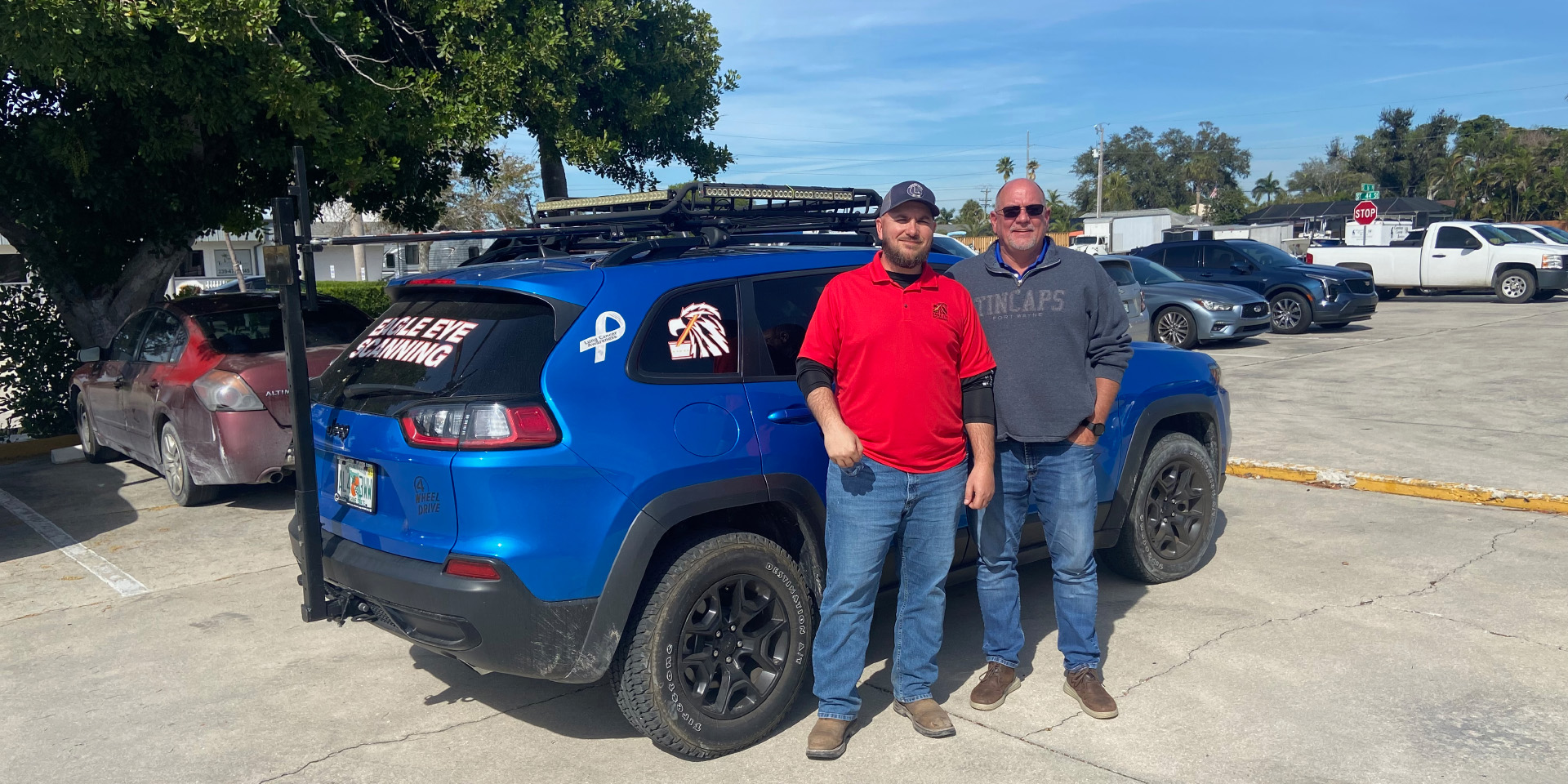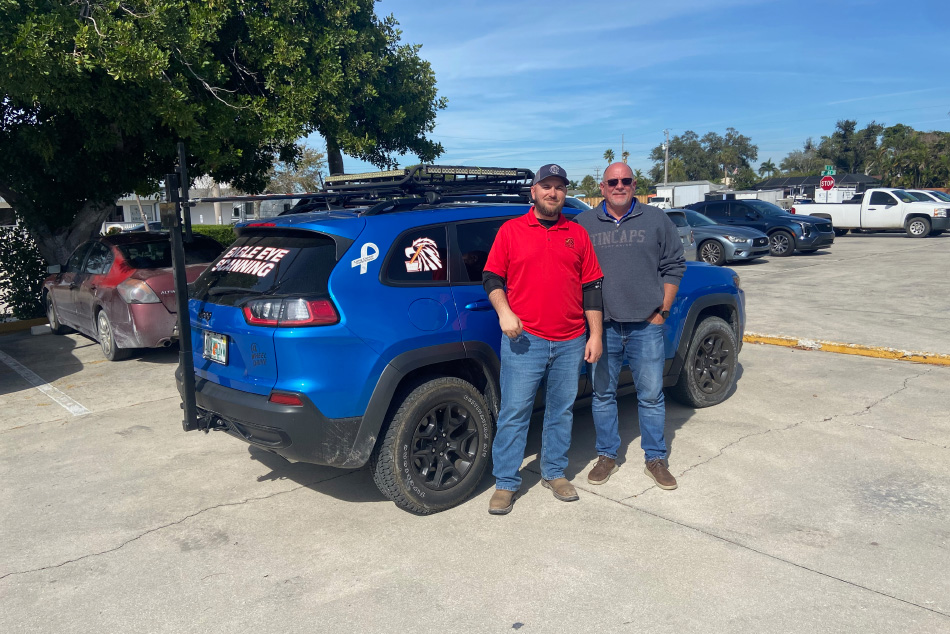People heading to Marco Island, the largest barrier island in the state’s Ten Thousand Islands area, have two options to gain access. One is the major SR 951 highway/bridge complex, the other, the more rural San Marco Road/CR 92. This road features a number of smaller bridges, which cross the area’s many streams and waterways. On one of these bridges, wear issues developed over time, resulting in a low spot so serious that it often caused trailers to become detached from the vehicles towing them. Looking for a quick, effective, budget-conscious solution to the problem, the contractor hired for the job met with Eagle Eye Scanning. Using a vehicle-mounted 3D laser scanner, the company scanned the roadway and problematic area and presented a design it said could meet the required 45% improvement in rideability. When complete, the eventual project easily beat those numbers, solidifying the scanner’s prominence in Eagle Eye’s workflow.
For this Florida scanning specialist, technology smooths out even the roughest issues.
Branching Out
Eagle Eye Scanning and its parent company, AA Surface Pro, Inc., are each the brainchild of Jacob Amann. More than a decade ago, Amann was the GPS survey manager for Ajax Paving and, with their approval, began creating digital models for other companies that used machine control technology. The popularity of that endeavor led Amann to amicably part ways with Ajax and form his own operation, AA Surface Pro (he still counts Ajax as a prime customer). A subsequent purchase of the aforementioned GPS scanning system enhanced opportunities for the company’s survey function to such a degree that it warranted creation of an offshoot, Eagle Eye Scanning.

It’s hardly surprising that AA Surface Pro — and, by extension, Eagle Eye Scanning — should be enjoying the success they are. Their knowledge of machine control technology stretches back more than a decade, and Amann has been surveying for twice that long. Today, the two entities employ 34 people and operate out of a pair of sites: their main location in Cape Coral, Florida and another about two hours northeast, in Lake Wales.
“Lake Wales is a smaller branch, but they do a lot of our northern projects — those in the Orlando and Central Florida area,” said Matt Fewox, the company’s operations manager. “Geographically, we try to work throughout southwest and central Florida, with a good deal of work in the Sarasota area. By leveraging our strengths in survey and machine control, we’ve become one of the more in-demand survey operations in the region. However, working with the team at Lengemann Corp., our regional Topcon dealer, we added a Topcon RD-M1 vehicle-mounted scanner a couple of years back. They also provided all the initial training to give us the familiarity we needed — that really set the stage for the establishment of Eagle Eye Scanning and a world of new possibilities.”
Beyond the Norm

Eagle Eye’s transition to the RD-M1 was a gradual one. The newly established company had a vision for the role the scanner would play in their business and felt that they — and the technology as it existed then — were not yet in sync. “We chose to focus on other areas of the business until we could realize our particular vision for the scanning solution,” said Brian Juenger, Eagle Eye’s president. “Once we did, however, demand for our services rose exponentially with its use.”
That “our particular vision” comment addresses the possibilities Eagle Eye saw for using the RD-M1, which is part of the Topcon SmoothRide intelligent paving system, well beyond traditional road scanning applications. According to Juenger, they felt strongly that doing so could open new doors for them.
“We knew the scanner could be a valuable tool for things like creating as-builts, working with engineers, etc.,” he said. “We also felt that the RD-M1 could excel in road construction and resurfacing work, projects that involved milling and paving. To do that, however, we needed a way to prove the viability of our vision. That would not be so easy.”
Eagle Eye’s team understood that purchasing an actual paver or milling machine in order to test its theory, was neither practical nor economically feasible. Again, thinking “outside the box,” they chose to mockup a flatbed trailer with a GPS solution in order to provide a true proof-of-concept.
“This was an extremely important step for us,” said Fewox. “We mounted an entire Topcon GPS-based paving solution: antennas, poles, brackets, cables, sensors, display, sonic trackers — literally everything was there except the machine itself — onto that trailer. But the effort paid off; after scanning and testing it on a road near our office, we were just beside ourselves with how accurate the results were. We knew we were onto something big.”
Real World Success
Eagle Eye did not have to wait long to see their vision come to life. Shortly after their successful mock runs, they were contracted by Preferred Materials, one of Florida’s leading suppliers of asphalt, concrete, concrete products, and paving services, to address work on the canal bridge mentioned above. According to Juenger, the need for repair could not have been more obvious.

“I believe representatives from both Collier County and Preferred Materials were doing a site visit when they saw a vehicle and boat trailer hit that area and become detached,” he said. “That pretty much told Collier County that they needed something done. They asked Preferred to come up with a new design for that road, the only stipulation being that it had to provide a 45% better ride than what was in place at the time.”
After talks with Preferred, Eagle Eye convinced them that, using the RD-M1 scanner, they could scan the existing road and build a design that could correct the problem and easily meet those criteria. After a couple of small tweaks, they were off.
Heart of the Matter

Mounted on a Jeep Cherokee, Eagle Eye’s RD-M1 scanner can scan at rates up to 100 times per second, delivering a detailed 3D point cloud depiction of existing surface conditions before a project begins. It also allows them to know, with confidence, the amount of material to be removed or placed for any given section of road — important for the canal bridge repair, according to Fewox.
“Because of budgetary constraints for the project, the County didn't want Preferred to make any drastic design changes and wanted to keep material costs down,” he said. “While filling in an extra inch here and there was fine, they didn't want depths to exceed three inches. Those demands fit perfectly with the data provided by the RD-M1 and were easily transferrable to the paving operation.”
After scanning, Eagle Eye uploads the data to their Cloud server, ready for processing. That facet of the work starts with importing it into Topcon Collage, then supplementing that data with info from a benchmarked HiPer VR base station. “We’ve found that combining Collage with the base station data gives us the tight accuracies we want,” said Fewox. “It’s been the real key to the work we can do with the scanner.”
Let it Ride
While results from the bridge project were immediately impressive, available data from MAGNET Office — depicting both pre- and post-paving — allowed Eagle Eye to quantify just how successful Preferred was in its efforts.
“We had MAGNET Office run a report for us, giving us something akin to an IRI (International Rideability Index) number,” said Fewox. “We first ran the rideability report on the existing surface, then did so again after it was paved and compared the two numbers. Just based on that raw data, the improvement was in the 60% range — well above the 45% they required. For us, that was huge, especially with a product we hadn't actually implemented in that way before.”

He added that they were particularly thrilled at proving a full-range concept: being able to scan, build a design, implement that design, scan post-project and then prove their ability to meet a predetermined goal. “We were definitely pleased, but even more excited for the possibilities we saw.”
“We first ran the rideability report on the existing surface, then did so again after it was paved and compared the two numbers. Just based on that raw data, the improvement was in the 60% range — well above the 45% they required. For us, that was huge, especially with a product we hadn't actually implemented in that way before.”
– Fewox
Taking it Beyond
Building on that scanning-based euphoria, Eagle Eye has moved into other areas, which are also traditionally labor-intensive or limited in scope. Acting in support of parent company AA Surface Pro, for example, they recently saved the day on a project called Causeway Commons.
“This was an apartment complex paving project for which AA Surface Pro was asked to gather a large number of as-builts at one time,” said Juenger. “Because they were really under the gun, we felt it was a perfect opportunity to tap the benefits of the scanner. We set the RD-M1 up between structures and were able to get all the sidewalk and curb on one side, the full road, and the curb and sidewalk on the other. Since we had already located the sanitary, storm grates and manholes, we had all of those to check against the scan and we were coming in within an eighth of an inch. It was fast and accurate, just what was needed.”
"We set the RD-M1 up between structures and were able to get all the sidewalk and curb on one side, the full road, and the curb and sidewalk on the other. Since we had already located the sanitary, storm grates and manholes, we had all of those to check against the scan and we were coming in within an eighth of an inch. It was fast and accurate, just what was needed."
– Juenger
More and Better
If saving the day via scanning was a prerequisite, however, Fewox offers another example that might serve even better. A local contractor, facing the possibility of a paving re-do, knew of Eagle Eye’s scanning strengths and turned to them for help.
“We saw that he was in a tough spot, so we went out and scanned that project,” said Fewox. “Fortunately, after scanning, we were able to prove to county engineers that what this contractor built matched the original design intent of the overall drainage plan. So, instead of having to replace a huge part of what was already done — which would have meant ripping out all the curb and most of the asphalt — he only had to replace 120 feet of curb. That saved him a ton of money and time and got Eagle Eye another satisfied customer.
“In this business, you're only as good as the tools that you use,” he added “With the RD-M1, we are getting the speed and accuracies that our customers — in a range of different applications — deserve. It’s a big part of our business today, and it will only get bigger.”
“In this business, you're only as good as the tools that you use,” he added “With the RD-M1, we are getting the speed and accuracies that our customers — in a range of different applications — deserve. It’s a big part of our business today, and it will only get bigger.”
— Fewox
Related articles
Get in touch
Thank you!
















